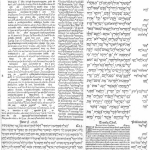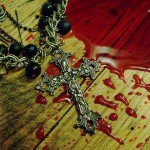Oklahoma City, Okla., Sep 13, 2017 / 03:16 am (CNA).- Unlikely. It’s a word often used to describe the story of Fr. Stanley Rother, an unlikely priest who came from an unlikely place in the middle of Oklahoma to take on an unlikely task and die an unlikely death, who is now on the unlikely path of becoming a canonized saint. All of it certainly seemed unlikely, at least for a while, to Fr. Stanley’s little sister, Sr. Marita, who has been a religious sister since the age of 17. One never really considers that saints could be found within one’s own family, Sister Marita told CNA. “As young people, when we learned about the saints, their backgrounds, why they became a saint, we said: ‘How did they do it? We could never do that!’” Sr. Marita recalled. “And then you see something like this in reality, and it puts a whole new perspective on life, on God’s purpose in our life and why we’re here.” Sr. Marita’s big brother will be beatified in Oklahoma City on September 23. Pope Francis officially recognized his martyrdom, clearing the way for his beatification, in December 2016. Fr. Stanley was killed in 1981 while serving at a mission parish in Guatemala, at which he had been stationed for 13 years. While at the mission, he had built schools, hospitals, wells and a Catholic radio station, as well as a strong rapport with and love for the people there. In the midst of Guatemala's civil war, Fr. Stanley briefly left the country in 1981, but returned to be with his parishioners, which cost him his life. For those who knew him as he was growing up, the idea that Stanley would become a great leader in the faith on the path to canonization would have seemed, well, unlikely. Growing up with quiet, ‘occasionally ornery’ Stanley “He was quiet, kind of bashful in a sense, so was I,” Sr. Marita said. “Introverted or whatever you want to call it.” She said she remembered teachers calling Stanley, herself and their next brother Jim the “three little bears” at school “because we were just like stairsteps” – very close in age. Stanley was well-behaved – they all were – at school, said Sr. Marita, because in a the small German Catholic town of Okarche, Oklahoma, surrounded by siblings and cousins and relatives, word spread fast if you decided to act up. But that doesn’t mean they wouldn’t get up to the occasional “ornery” thing on the farm, Sr. Marita added. One time in particular stood out to her. She was checking the hen house for eggs with Stanley when he asked her to reach up and check under a hen that she was sure had already been checked. “And I said ‘well you just did it,’ and he said ‘I didn’t do that one.’ So I reached in,” Sr. Marita recalled. But instead of grabbing a chicken egg, she got a hold of a big (non-venomous) bull snake that had been hiding out in the chicken house. “And that made me really mad at him, so I chased him to the house for it,” Sr. Marita recalled. “He got halfway there and I picked up a can from the yard and flung it at him...and it hit him right over the eye. He had a scar there the rest of his life,” she said. “I got in trouble for that one, because I could have hit him in the eye.” “But that was probably the orneriest thing he did. That was such a scare for me, and he thought it was so funny, and he knew that it wouldn’t hurt me,” she said, laughing. Stanley was busy helping his parents on the farm, and became president of the school’s chapter of Future Farmers of America, an agricultural club. He was talented at farming, Sr. Marita said, but he couldn’t ignore God’s call. Fostering a vocation There are some things about Fr. Stanley’s story that are not so unlikely. The fact that his vocation was fostered in the family home in Okarche, Oklahoma, where life revolved around family, farming, and the Catholic schools and parishes, seems very likely. In fact, there was a lot of discernment about vocations within the Rother family. Sr. Marita said she doesn’t remember who told their parents first, but she and Stanley both declared that they were pursuing vocations the same summer – he would enter seminary, and she would enter religious life. Stanley had just finished high school, and Sr. Marita still had a year left. They hadn’t discussed their decisions with each other before telling their parents. “We never talked about it that much in the family,” she said, as far as discerning vocations. But they were surrounded by family and friends who shared their morals and values, and they prayed together daily. “We went to Mass, and any time there was prayer in the church we were there. The school was a tremendous support as far as building on what the family had done, and the rosary in our family was an everyday occurrence,” Sr. Marita said. “After our evening meal we knew that we would kneel for a good 20 minutes, it was our prayer time. And I don’t think we realized the importance of that until we moved on in life.” The Rother’s parents, Franz and Gertrude, were supportive of their vocations, although they did report that the dinner table felt a little lonelier when it suddenly shrank from six to four. Bright, but in unexpected ways Never much for academics, Stanley would struggle when he entered seminary in San Antonio, Texas. Latin was particularly difficult for him, so much so that he ended up failing out of his first seminary. When he returned to his home diocese, they offered him a second chance at Mount St. Mary’s Seminary in Emmitsburg, Maryland. There, he was able to receive the tutoring he needed to eventually graduate and be ordained. Fr. Donald Wolf is the second cousin of Fr. Stanley Rother, on his mother’s side. Fr. Wolf told CNA that while everyone would “make a big deal” out of Fr. Stanley’s “not being very bright” academically, Fr. Stanley excelled in other areas. “Everybody makes a big deal of the fact that he was asked to leave the seminary, he was never any good at Latin, and his studies were just not the first thing on his mind,” Fr. Wolf said. “But he was, as his father was, a really really good mechanic. Not just that he kind of knew how to fix things, I mean he was really brilliant at that kind of stuff, and really really capable,” he recalled. “So one of the things that marked his life was his mastery of those things - carpentry and masonry and plumbing and mechanics in a really remarkable way. So he did not think of himself as a failure, nor did his family. It was one of those attributes which his father had times 10 – his ability to solve problems, and his sense that he could do anything.” The perfect fit: called to mission When Stanley was still in seminary, Pope St. John XXIII asked the churches of North America to establish missions in Central America. Soon after, the diocese of Oklahoma City and the Diocese of Tulsa established a mission in Santiago Atitlan in Guatemala, a poor rural community of mostly indigenous people. Five years after he was ordained, Fr. Stanley asked to join the mission team, where he would spend the next 13 years of his life. Although Guatemala was a long way from Okarche, the decision seemed to make sense to everyone – priests, family and Fr. Stanley himself believed this mission would be a “perfect fit,” Fr. Wolf said. “Part of that was he just never fit in very well around here” as a priest in the diocese, Fr. Wolf said. “He wasn’t very articulate, he wasn’t pushing for change everywhere, he wasn’t one of those guys who could attract notice...so when he volunteered to go to the mission, to do the kind of things that he could do well – taking care of the mechanical needs, taking care of the plants, making sure the plumbing worked and that the electricity stays on – everyone figured that was a perfect position for him, and he figured that it was a perfect position for him.”Fr. Stanley, tri-lingual pastor extraordinaire For Sr. Marita, however, finding out her brother volunteered to go on mission to Guatemala was kind of a shock. The two had had limited contact since joining religious life, and communicated mostly through letters, in which Fr. Stanley never expressed a desire for the missions. “I had no idea he was leaning in that direction,” she recalled. It wasn’t until she was able to visit him in Guatemala – once in 1973 and again in 1978 – that she was able to watch him in action and see how well it suited him. By that time, Stanley, the Latin flunkie, had mastered Spanish and the local native Tzutuhil dialect, and had won over the hearts of the people, who seemed to swarm around him everywhere he went, she recalled. “To see him in that vein was a grace, because I did not know that about him, how compassionate he was with people, how he responded with the young people, they would flock around him, come to chat when they saw him coming down the road.” She said she remembered watching him help some young people fix a truck that had broken down – a chance to use his master mechanical skills. During his time at the mission, he also built a farmers' co-op, a school, a hospital, and the first Catholic radio station, which was used for transmitting catechesis to the even more remote villages. “He evolved very quickly into his role as pastor, as someone who was tri-lingual. He was, it would appear, perfectly equipped to take care of the challenges of the people in the middle of the challenges of that place,” Fr. Wolf said. ‘Absolute, resolute stubbornness’ Over the years, the violence of an ongoing Guatemalan civil war inched closer to Fr. Stanley’s once-peaceful village. Disappearances, killings and danger soon became a part of daily life, but Fr. Stanley remained steadfast and supportive of his people. “The shepherd cannot run at the first sign of danger,” Fr. Stanley wrote in a letter home, which would become his signature quote. “Pray for us that we may be a sign of the love of Christ for our people, that our presence among them will fortify them to endure these sufferings in preparation for the coming of the Kingdom.” In 1980-1981, the situation reached a boiling point. At the behest of friends and family and with his name on a hit list, Fr. Stanley returned to Oklahoma for a few months in January 1981. But as the weeks and months went on and as Easter approached, he was anxious to get back to the mission. “He really did become one of them, and they claimed him as one of them, so when you leave someone you really love, you want to be there for them,” Sr. Marita said. In Guatemala, Holy Week is “a lived experience, it’s not just portrayal, so he wanted to be back for that, and celebrate that with them,” Sr. Marita recalled. Sr. Marita was able to visit Fr. Stanley while he was home that winter. It was the last time she would see her older brother alive. “As we talked about it, I realized more and more, that no matter what any of us said, he knew that he had to listen to how God was speaking to him (and return). And we accepted that, we weren’t too surprised that that was what he wanted to do.” But not everyone was so supportive of his decision. Fr. Wolf said for years, many people, including people within the family, considered Fr. Stanley’s decision to leave the safety of the United States and face almost certain death as another sign that he just wasn’t very bright. “One of my uncles in particular just was not at all impressed with Stanley’s decision to do this,” Fr. Wolf said. Still, it wasn’t surprising to anyone who knew Fr. Stanley or the Rother family that once his mind was made up, there was little anyone could do to change it. “One of the attributes of the Rother family – just ask around – is absolute, resolute stubbornness that they’re going to do what they’re going to do,” he said. “And the Lord builds the supernatural upon the natural, and that was one of the natural attributes that he worked with, because Stanley was not going to be deterred.” “But if you ever spent 10 minutes with his father you’d know that that’s something he came by perfectly naturally. His father, his father’s brothers, my mother, her brothers and sister - I mean it is a pretty tough crowd,” Fr. Wolf added with a laugh. So Fr. Stanley returned in time to celebrate Easter with his people. A few months later, at 1:30 in the morning on July 28, 1981, three armed hitmen broke into the rectory where Fr. Stanley was sleeping. They were known for their kidnappings, and wanted to turn Father Stanley into one of “the missing.” Not wanting to endanger the others at the parish mission, Fr. Stanley struggled but did not call for help. Fifteen minutes and two gunshots later, Fr. Stanley was dead. The men fled the mission grounds.Fr. Stanley’s legacy While the rest of Fr. Stanley’s body was buried in Okarche, his heart remained in Guatemala, and will become a relic once he’s beatified. Sr. Marita said that in Guatemala, they were quick to call him a martyr, while the legacy of her brother’s witness continued to grow in Oklahoma over the years. “Bishop (Eusebius) Beltran told my parents that he’ll be considered a saint one day, and they felt very strong about it, they had that to dream about at least before they died,” she said. Gertrude Rother would pass away in 1987, just a few years after her son, and Franz Rother died in 2000. The Archdiocese of Oklahoma City officially started working on the cause of Fr. Stanley in 2007, though the church in Guatemala had already gotten it off the ground. “When they started doing the interviewing it became more of a reality to everybody, that it would be for promoting his cause,” Sr. Marita said. “It really is difficult for me to express in certain terms, but I am deeply grateful and proud of him. It’s an awesome experience, one that you would never dream of in your own family,” she said. When asked what she hoped others learned from her brother’s witness, Sr. Marita said she hoped they would notice the steadfast faith with which he answered the call of God and gave his last breath serving others. “It goes way back to his ordination card, which said: ‘For myself I am a Christian, for the sake of others I am a priest,’” she said. “I feel like he really lived that out. I think young people today don’t know if they’re called to the priesthood or religious life, but we have to listen to the first call – come follow me – and then every day continue to follow him and hear that call from him.” Fr. Wolf echoed her sentiments. “It was his yes to what he was called to,” he said, “that manifests itself with his desire to remain there and to serve the people.” “But it began when he said yes to his first invitation to vocation, when he said yes even after failing out of seminary, when he said yes at his ordination, and when he said yes to going to the mission and his yes to remain there after all the other Oklahomans had left.” Fr. Rother will be beatified Sept. 23 at the Cox Convention Center in Oklahoma City. The Mass will be celebrated by Cardinal Angelo Amato, prefect of the Congregation for the Causes of Saints, and concelebrated by Archbishop Paul Coakley of Oklahoma City. It will likely be a fitting celebration for a life of most unlikely circumstances. Read more















